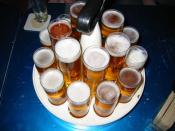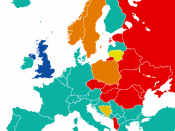BLOOD ALCOHOL LEVEL (BAL)
MONITORING
The amount of alcohol in your blood stream is referred to as Blood Alcohol Level
(BAL). It is recorded in milligrams of alcohol per 100 milliliters of blood, or milligrams
percent. For example, a BAL of .10 means that 1/10 of 1 percent (or 1/1000) of your total
blood content is alcohol. When you drink alcohol it goes directly from the stomach into
the blood stream. This is why you typically feel the effects of alcohol quite quickly,
especially if you haven't eaten for a while. BAL depends on: 1. Amount of blood (which will
increase with weight) and 2. The amount of alcohol you consume over time (the faster you
drink, the higher your BAL, as the liver can only handle about a drink per hour--the rest
builds up in your blood stream).
Understanding the effects of a rising BAL can be very useful in controlling drinking.
Below are the consequences of various Blood Alcohol Levels,from a book by William R. Miller
and Ricardo F. Munoz called, 'How to Control your Drinkling: A Practical Guide to
Responsible Drinking (1982):
.02 MELLOW FEELING. SLIGHT BODY WARMTH. LESS
INHIBITED.
.05 NOTICEABLE RELAXATION. LESS ALERT. LESS SELF-
FOCUSED. COORDINATION IMPAIRMENT BEGINS.
.08 DRUNK DRIVING LIMIT. DEFINITE IMPAIRMENT IN
COORDINATION AND JUDGMENT.
.10 NOISY. POSSIBLE EMBARRASSING BEHAVIOR. MOOD
SWINGS. REDUCTION IN REACTION TIME.
.15 IMPAIRED BALANCE AND MOVEMENT. CLEARLY DRUNK.
.30 MANY PASS OUT.
.40 MOST PASS OUT; SOME DIE.
.50 BREATHING STOPS. MANY DIE.
As can be seen, the most reliably pleasurable effects of alcohol occur when
BAL rises to about .03-.05. Alcohol researchers have discovered that low levels of
alcohol have a specific effect on thinking; alcohol results in a reduction of 'self-
monitoring.' (Hull & Reilly, 1986). What this means is that small quantities of...


